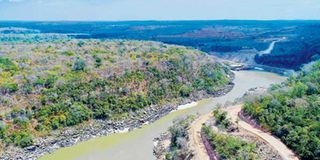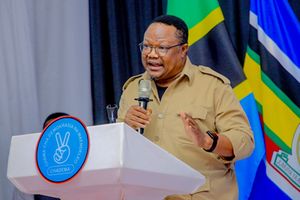Magufuli orders Selous Reserve split into two

Rufuiji river at Pwan region.
Dar es Salaam. President John Magufuli yesterday directed the division of Selous Game Reserve into two to establish a new National Park to be named after founding President Julius Kambarage Nyerere.
The President said Nyerere National Park will be in honour of the legacy of the former President on environmental conservation. He was speaking during the laying of the foundation stone for the construction of the 2,100MW Rufiji Hydropower Project (Stiegler gorge).
Egyptian minister of energy Dr Mohamed Shaker El-Markabi and PM Kassim Majaliwa attended the function among other top state officials.
President Magufuli explained that the new park will help the country to generate more revenue from tourism. If established, it will be the 20th National Park, following the recently established Burigi-Chato National Park in Geita and Kagera regions.
“This park will see us receive many tourists hence more revenues while we will also continue to earn money from 47 hunting blocks in the reserve,” said the President of the 54,600 square kilometre or 5,120,000 hectares property. Selous is one of the largest game reserves in Africa.
The decision to subdivide and open the game reserve to mass visitors will likely fuel more debate regarding Tanzania’s management of the world famous site. The United Nations Educational, Scientific and Cultural Organization (Unesco) lists Selous as an endangered World Heritage site.
Unesco has expressed reservation on the government’s decision to establish the mega power project within the reserve and has asked the government to show concrete measures on its conservation.
This position by Unesco and that of other environmentalists who have opposed the power project has been dismissed by the government and also some local advocates in the country as overly exaggerated and defended the desire by Tanzania to use the dam to become power sufficient to drive its industrialization agenda.
During Unesco’s 43rd session of the World Heritage Committee meeting in Baku, Azerbaijan, in July 2019, the body tasked with protecting such endangered sites reinforced Selous’s monitoring mechanism.
The committee also reported that an independent expert review of the Environmental Impact Assessment (EIA) of the project fell considerably short of acceptable standards and that it does not provide a best practice assessment of the potential impacts on the property’s Outstanding Universal Value (OUV).
According to the published committee report, the construction work has started before completion of a Strategic Environmental Assessment (SEA) undertaken to the highest international standards as promised. It has appealed that the government allow a joint World Heritage Centre/IUCN Reactive Monitoring mission for assessment. President Magufuli who presided over yesterday’s function reiterated his criticism of those opposed to construction of the dam and said they did not hold the interest of the nation at heart. He allayed fears that its implementation will negatively impact the environment. He said about 32.5 per cent of Tanzania’s landmass is under conservation.
“I know many people from inside and outside the country oppose the project by claiming it has a negative environmental impact but the fact is the project will have many positive impacts,” he noted.
He said the dam only occupies 1.922 per cent out of the reserve area.
On the new national park, the President said it should occupy a large portion of the reserve and the rest left for hunting activities. He said, however, that the country’s approach to tourist hunting may be less paying. He said one hunting bloc costs $5000 (Sh11.5 million) per month, an amount he said could be recovered with the killing of 10 buffalos.
According to President Magufuli, other countries allowed spot hunting on private ranches and not on free range as is the case for Tanzania. He wondered why conservationists only complained about the establishment of the dam within the reserve and not the many hotels. He said plans to open a national park had been undermined by interest parties in the hunting industry. “They are the same people who are opposed to the dam,” he said.
The ministry of tourism has introduced new mechanisms for issuance of hunting blocs this year. Reports indicate that the exercise has not taken off smoothly over stringent measures, with sources within the Tanzania Wildlife Agency hinting that more than half of the blocs were still vacant as applications few.
An Egyptian company has started work on the dam that will cost Sh6.5 trillion. Some 1 trillion has already been paid by the government. Energy minister Medard Kalemani said it will be completed in the next 35 months. More than 6000 direct and indirect jobs will be generated, the minister added.




